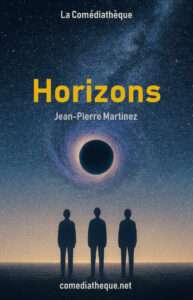
In a desolate no man’s land that feels like a purgatory, three characters who have lost their memory stare toward the horizon, searching for answers to their existential questions. But which horizon is it, exactly? A tragicomedy blending science and philosophy, a reflection on the eternal cycle of life and death.
Original title in French : Horizons
English translation by Jean-Pierre Martinez
Cast : the characters are of unspecified gender. Possible distributions: 3M, 3F, 2M/1F, or 1M/2F.
A play written in October 2025
Spanish translation by Jean-Pierre Martinez : Horizontes
Portuguese translation by Jean-Pierre Martinez : Horizontes
Abstract
Horizons is a tragicomic meditation on consciousness, memory, and the limits of human understanding. Set in an undefined purgatorial space, the play follows three gender-neutral characters—Ben, Dom, and Max—who have lost their memory and face an ever-shifting horizon in search of meaning. Through their dialogue, Martinez turns the stage into a metaphysical laboratory where language becomes both a tool and a trap: a window onto the world and a cage enclosing thought.
Drawing on the legacy of Beckett and Ionesco, Horizons extends the tradition of the Theatre of the Absurd into the twenty-first century. Where Beckett’s Endgame ends in silence and Ionesco’s The Chairs in void, Martinez’s characters persist—still speaking, still questioning, still bound together by the need to make sense. Mixing humour, scientific imagery, and existential irony, the play transforms despair into cosmic curiosity. The horizon—optical, metaphysical, and linguistic—becomes the ultimate metaphor for the human condition: the endless pursuit of meaning just beyond our reach.
Analysis
A tragicomic meditation on memory, language, and the limits of human understanding.
1. Overview
Horizons takes place in an undefined, liminal space — a “no man’s land that looks like a kind of purgatory.” Three characters who have lost their memory — Ben, Dom, and Max — find themselves together, staring toward a mysterious horizon that seems to shift, recede, or approach depending on their perceptions.
What begins as a comic, almost absurd situation soon evolves into a philosophical and existential reflection on consciousness, identity, and the cyclical nature of life and death. The horizon itself becomes a metaphor for the limits of human knowledge — both physical and metaphysical.
2. The Setting: Between Worlds
The action takes place on an empty stage bathed in an unreal light. The characters appear suspended between existence and non-existence, between life and death, between dream and reality.
This timeless and spaceless environment turns the play into a kind of metaphysical laboratory, where language is the only tool the characters have left to make sense of their condition.
The horizon — invisible yet omnipresent — functions as a moving boundary between:
the visible and the invisible,
the known and the unknowable,
the self and the other,
life and death.
It is both the limit of perception and the promise of transcendence.
3. The Characters: Mirrors of Thought
Although their gender is indeterminate (and the play explicitly allows for multiple casting combinations), the three characters — Ben, Dom, and Max — function less as psychological individuals than as personified facets of human consciousness. They can be seen as three voices within a single mind, or three different ways of relating to reality.
Ben — The Humanist and Mediator
Ben often acts as a bridge between the extremes. He questions, observes, and tries to make connections.
He embodies curiosity and empathy, but also a certain helplessness. He oscillates between hope and scepticism, between faith in meaning and awareness of absurdity.
When he says, “As long as we’re talking, we’re not dead yet,” he captures the essential human impulse to speak in order to exist.
Ben is the seeker of meaning — the part of us that cannot stop asking “why?” even when no answer comes.
Dom — The Ironist and the Rebel
Dom is the most cynical, sarcastic, and earthy of the trio. He constantly challenges the others’ assumptions and mocks philosophical pretension.
His humour is biting, and he often brings the conversation back to the absurdity of their situation.
At the same time, his rebellion hides a deep existential despair: the need to affirm his freedom in a situation where no freedom remains.
Dom is the voice of revolt — the part of us that resists resignation, that needs to laugh in the face of the void.
Max — The Thinker and Theorist
Max is the one who quotes physics, metaphysics, and philosophy. He’s fascinated by scientific metaphors: the curvature of the Earth, the event horizon, Schrödinger’s cat, black holes.
His reasoning is rigorous but sterile — he keeps trying to rationalize the inexplicable.
Through Max, Martinez caricatures the modern rational mind, endlessly analysing, naming, and conceptualising — yet unable to escape the prison of language.
Max is the intellect — the voice of reason that ultimately confronts its own limits.
Together, these three create a triangular dynamic:
Ben connects,
Dom destabilises,
Max explains.
Their dialogue becomes a theatrical dialectic — a back-and-forth between sense and nonsense, hope and despair, language and silence.
4. Structure and Dramatic Progression
The play unfolds in four short scenes, each marking a shift in perception or awareness.
| Scene | Setting / Event | Dramatic Function |
|---|---|---|
| 1 | The three characters discover they are facing the horizon. They question what lies beyond and try to remember who they are. | Establishes the situation and philosophical tone. The theme of memory and perception emerges. |
| 2 | Memories resurface — fragments of planes, hospitals, and disasters. | Introduces doubt: are they dead, dreaming, or in a coma? The “event horizon” metaphor appears. |
| 3 | Hypotheses multiply: were they mountaineers, astronauts, or patients? | The dialogue becomes a cosmic allegory — identity dissolves into collective consciousness. |
| 4 | Dom decides to walk toward the horizon. The others join him. They tie themselves together and move toward the audience. | The metaphysical finale: hope, irony, and the cyclical return of existence. |
Each scene redefines the meaning of the horizon — as optical illusion, boundary of death, scientific limit, and finally as a threshold of renewal.
5. Themes and Motifs
* The Horizon as a Metaphor
The central image represents:
The limits of perception (scientific: the curvature of the Earth);
The limits of life (death as the horizon we cannot cross);
The limits of knowledge (language as both window and cage).
Every attempt to define the horizon pushes it further away — just as every attempt to define truth or meaning only multiplies perspectives.
* Language and its Limits
The play continually reflects on the power and impotence of words.
Dom calls language “a grid that traps us inside the only reality our senses can perceive.”
Max tries to explain existence through science and logic.
Ben keeps using metaphors, even when he realises they might be meaningless.
Ultimately, their speech becomes a loop — a self-referential performance of thought chasing itself.
* Life, Death, and Rebirth
Drawing on both Eastern and Western philosophies, the play suggests a cyclical conception of existence.
Whether in a plane crash, a hospital coma, or a spaceship drawn into a black hole, each scenario symbolises the transition between worlds, the eternal recycling of energy — “the great recycling.”
Death, in Horizons, is not an end but a change of state — like matter or light disappearing beyond the event horizon.
* Memory and Identity
Having forgotten who they are, the characters must reinvent themselves.
Their amnesia becomes a metaphor for human finitude: we define ourselves through memory, but memory itself is unreliable and selective.
In the end, forgetting everything might be the ultimate freedom — “At least we’ll have forgotten everything, and we’ll be able to marvel again at being alive.”
6. Tone and Style
The tone oscillates between:
Philosophical gravity (discussions of consciousness, death, the universe),
Absurd humour (wordplay, irony, mock-science),
Poetic lyricism (repetitions, musical phrasing, imagery).
Martinez masterfully blends existential theatre (Beckett, Ionesco) with a lighter, more ironic touch, producing something accessible yet profound — a tragicomedy of metaphysical bewilderment.
7. Symbolic Ending
The ending — where the three characters tie themselves together and walk toward the horizon — can be read as:
a gesture of solidarity in the face of the unknown,
a metaphor for humanity’s collective journey toward its own limits,
and a final ironic twist: as the lights fade, they never reach their “Saviour,” yet keep faith all the same.
The horizon of events thus becomes the horizon of theatre itself — the edge where illusion and meaning dissolve into darkness.
Conclusion
Horizons is both a metaphysical fable and a play about language — a poetic confrontation with the unknowable.
Jean-Pierre Martinez uses humour, repetition, and paradox to explore the great questions:
Who are we? What lies beyond? Why do we speak at all?
Through Ben, Dom, and Max, he stages the eternal human dialogue between faith, doubt, and reason — between the desire to know and the impossibility of knowing.
